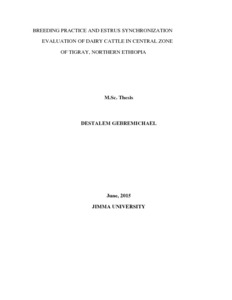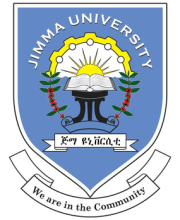Resource information
The study was conducted in central zone, Tigray, Northern Ethiopia, aimed with assessment of breeding practices and evaluation of estrus synchronization of dairy cattle. The study of the survey covered 180 households found in per-urban and rural areas of Ahferom, Adwa and Laelay michew district which included 113 in rural areas and 67 in per-urban areas of the districts. The Information was collected from secondary data, group discussion, AI technician, household level survey questionnaire, farm visit and personal observations. Seven hundred one synchronized cows were selected form record of artificial insemination centre and evaluated for conception rate and number of service per conception. For experimental study a total of 126 dairy cattle 42 cows from each district were selected for PGF2? treatment. Single shot of PGF2? were given for dairy cattle that exhibited estrus after first injection and double shot has given to cows that failed to show heat after single injection. Twenty conceived lactating cows were used for progesterone profile assay using hormonost micro lab farmers test to check pregnancy and embryo mortality. The data were analyzed using SPSS (16) and SAS (9.1). Dairy cattle were kept for generating income (35.6%), milk consumption (32.2%) and milk consumption and breeding (16.1%) in the study area. Purchased dairy cattle (69.9% and 68.7%) were the main foundation stock followed by own (20.35% and 17.91%) in rural and per-urban areas respectively. Mating system in the study area were AI (42.8%), AI with estrus synchronization (22.2%) and natural mating (35%). Households obtained breeding bull from neighboring (61.4%), own (21.3%) and village (17.3%). Individual performance and pedigree selection were used as selection criteria for dairy cattle. Trait preference of farmers were milk yield (1st) body weight (2nd)) and fertility (3rd) for both rural and per-urban areas. Production system significantly affected daily milk yield of local cattle and cross dairy cattle. In the study area AFC (3.9± 0.8, 3.0± 0.9) years, CI (1.7± 0.4, 1.3 ±0.5) years and DO (10.9 ±0.5, 6.9± 0.62) months were for local and cross cattle respectively. Overall CR and NSC of mass synchronization were 37.95% and 2.63 respectively. BCS, bull and AI technician significantly affected CR and NSC in mass synchronization. From single injection in the experimental study 84.9% cows responded to PGF2? and 51.4% of them were conceived. 89.5% Cows show estrus sign and 52.9% conceived with double injection. Among 20 cows assumed to be pregnant on basis of milk progesterone concentration on day 18-24 post insemination, 85% were confirmed to be pregnant and 15% showed late embryonic death. Community based breeding program is the best option to improve dairy breeding practice in the study area. Improvements in facilities and management should be necessary before implementing an estrous synchronization program. Giving second injection for cows not responded for first injection of PGF2? has complimentary advantage to single injection. Progesterone assay using hormonost micro lab farmers test is a practical solution for dairy farmers to detect estrus, pregnancy and embryo mortality.



